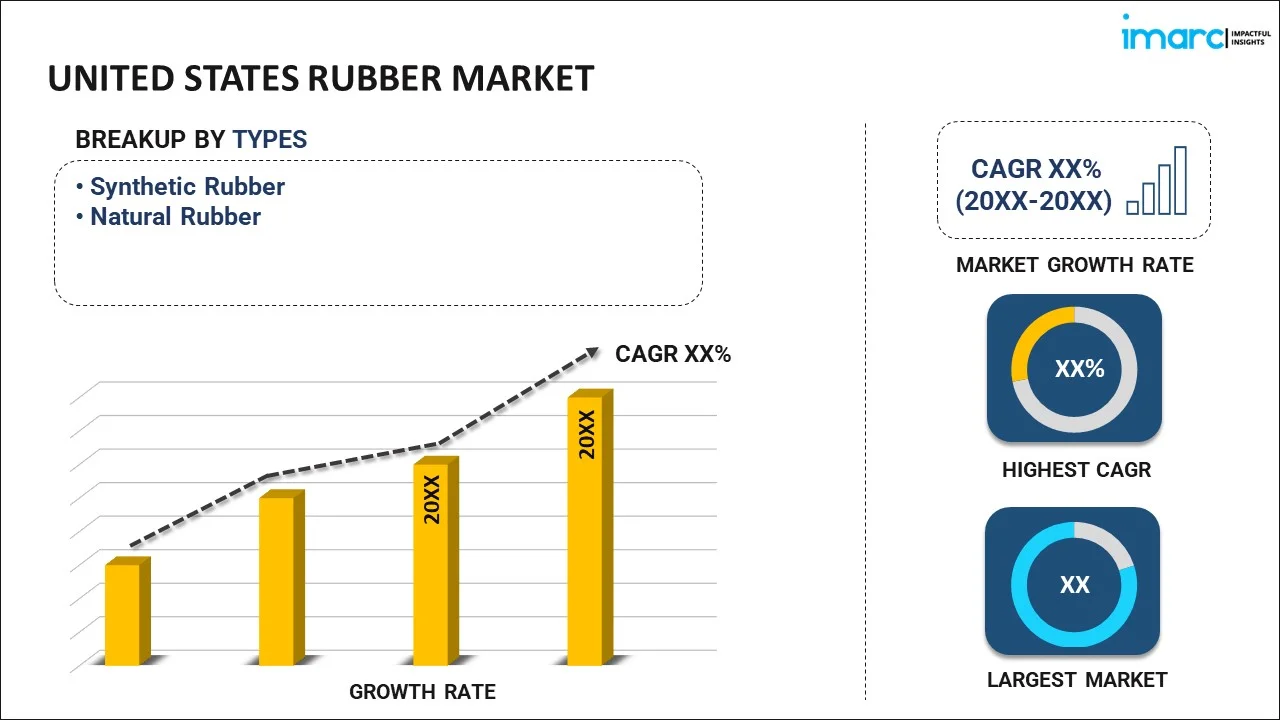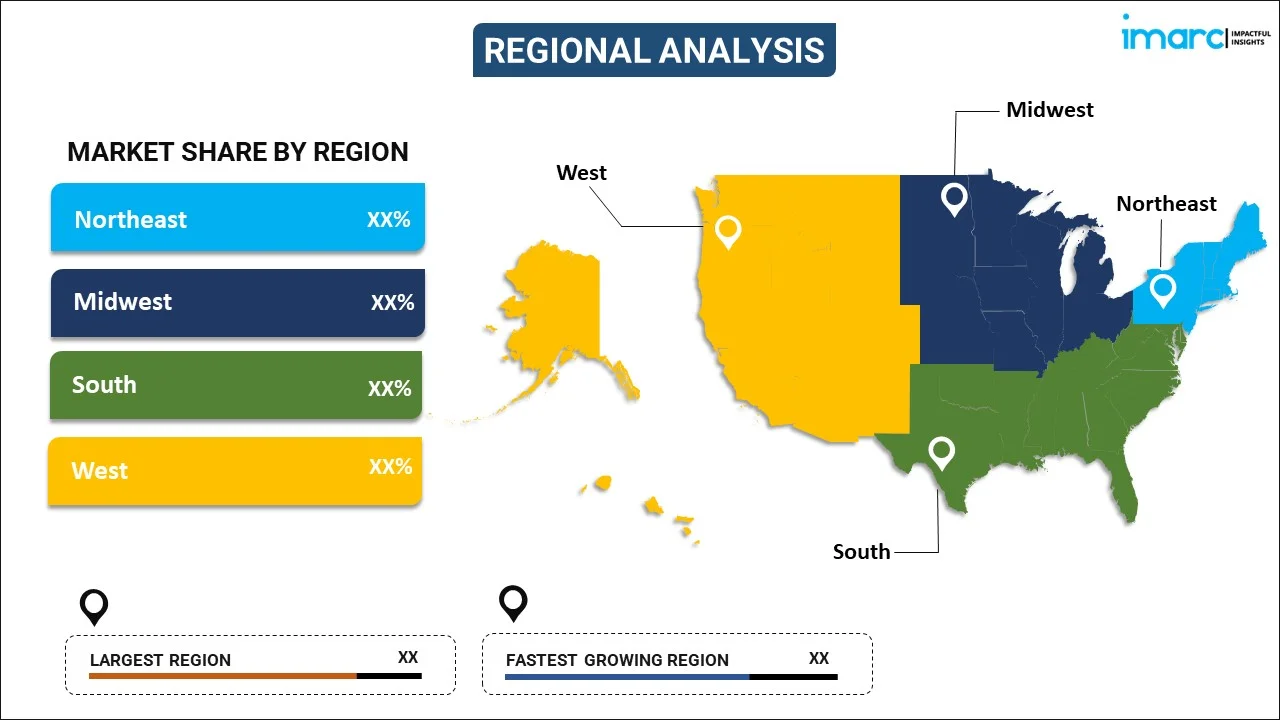
United States Rubber Market Report by Type (Synthetic Rubber, Natural Rubber), Application (Tire, Non-Tire Automotive, Footwear, Industrial Goods, and Others), and Region 2024-2032
Market Overview:
The United States rubber market size is projected to exhibit a growth rate (CAGR) of 5.00% during 2024-2032. The significant expansion of the automotive industry, the ongoing research and development (R&D) efforts within the rubber industry, and the widespread adoption of rubber in infrastructure development projects, including road construction and maintenance represent some of the key factors driving the market.
|
Report Attribute
|
Key Statistics
|
|---|---|
|
Base Year
|
2023 |
|
Forecast Years
|
2024-2032 |
|
Historical Years
|
2018-2023
|
| Market Growth Rate (2024-2032) | 5.00% |
Rubber is a versatile and essential material that is essential in various industries. It is a natural polymer derived primarily from the latex sap of rubber trees, scientifically known as Hevea brasiliensis, while synthetic rubber is produced through chemical processes. This remarkable substance exhibits unique properties that make it highly sought after and indispensable in many applications. Natural rubbers are obtained from latex, a milky, white fluid that is collected by tapping the bark of rubber trees, which consists mainly of a polymer called cis-1,4-polyisoprene. It has outstanding elasticity and resilience, making it ideal for manufacturing various products such as tires, rubber bands, footwear, and medical gloves. It can withstand extreme temperatures and resist abrasion and tearing, which makes it a preferred choice for these applications. Additionally, synthetic rubber is produced from petrochemical feedstocks through a series of chemical processes which was developed as a response to the increasing demand for rubber during World War II when natural rubber supply was limited. Synthetic rubber also exhibits impressive flexibility, durability, and resistance to various environmental conditions. It is commonly used in automobile tires, industrial belts, and several consumer goods. Nowadays, rubber is an essential component in the production of conveyor belts, hoses, and various machinery parts.
United States Rubber Market Trends:
The market is primarily driven by the growing automotive industry. In addition, the increasing use of rubber to produce tires and various components due to the growing economy, rising consumer demand for new vehicles, and several advancements in electric and hybrid vehicles require rubber components, thus contributing to the market growth. Moreover, several technological advancements, including the development of high-performance rubber compounds that offer better durability and fuel efficiency, represent another major growth-inducing factor. These innovations attract manufacturers looking to improve the quality of their products, further driving the market growth. Besides this, the widespread adoption of rubber in infrastructure development projects, including road construction and maintenance, is accelerating the demand for rubber products such as tires. Along with this, the government's focus on improving and expanding the nation's infrastructure has led to increased tire sales and, subsequently, growth in the rubber market, further propelling the market growth. In addition, the increasing demand for rubber in the manufacturing of tires, automotive parts, industrial machinery, and consumer goods, is influencing the market growth. Apart from this, the ongoing research and development (R&D) efforts within the rubber industry resulted in the creation of innovative rubber products that cater to specific industry needs, further creating a positive market outlook.
United States Rubber Market Segmentation:
IMARC Group provides an analysis of the key trends in each segment of the market, along with forecasts at the country level for 2024-2032. Our report has categorized the market based on type and application.
Type Insights:

- Synthetic Rubber
- Natural Rubber
The report has provided a detailed breakup and analysis of the market based on the type. This includes synthetic rubber and natural rubber.
Application Insights:
- Tire
- Non-Tire Automotive
- Footwear
- Industrial Goods
- Others
A detailed breakup and analysis of the market based on the application have also been provided in the report. This includes tire, non-tire automotive, footwear, industrial goods, and others.
Regional Insights:

- Northeast
- Midwest
- South
- West
The report has also provided a comprehensive analysis of all the major regional markets, which include the Northeast, Midwest, South, and West.
Competitive Landscape:
The market research report has also provided a comprehensive analysis of the competitive landscape. Competitive analysis such as market structure, key player positioning, top winning strategies, competitive dashboard, and company evaluation quadrant has been covered in the report. Also, detailed profiles of all major companies have been provided.
United States Rubber Market Report Coverage:
| Report Features | Details |
|---|---|
| Base Year of the Analysis | 2023 |
| Historical Period | 2018-2023 |
| Forecast Period | 2024-2032 |
| Units | US$ Million |
| Scope of the Report | Exploration of Historical Trends and Market Outlook, Industry Catalysts and Challenges, Segment-Wise Historical and Future Market Assessment:
|
| Types Covered | Synthetic Rubber, Natural Rubber |
| Applications Covered | Tire, Non-Tire Automotive, Footwear, Industrial Goods, Others |
| Regions Covered | Northeast, Midwest, South, West |
| Customization Scope | 10% Free Customization |
| Report Price and Purchase Option | Single User License: US$ 3699 Five User License: US$ 4699 Corporate License: US$ 5699 |
| Post-Sale Analyst Support | 10-12 Weeks |
| Delivery Format | PDF and Excel through Email (We can also provide the editable version of the report in PPT/Word format on special request) |
Key Questions Answered in This Report:
- How has the United States rubber market performed so far and how will it perform in the coming years?
- What has been the impact of COVID-19 on the United States rubber market?
- What is the breakup of the United States rubber market on the basis of type?
- What is the breakup of the United States rubber market on the basis of application?
- What are the various stages in the value chain of the United States rubber market?
- What are the key driving factors and challenges in the United States rubber?
- What is the structure of the United States rubber market and who are the key players?
- What is the degree of competition in the United States rubber market?
Key Benefits for Stakeholders:
- IMARC’s industry report offers a comprehensive quantitative analysis of various market segments, historical and current market trends, market forecasts, and dynamics of the United States rubber market from 2018-2032.
- The research report provides the latest information on the market drivers, challenges, and opportunities in the United States rubber market.
- Porter's five forces analysis assist stakeholders in assessing the impact of new entrants, competitive rivalry, supplier power, buyer power, and the threat of substitution. It helps stakeholders to analyze the level of competition within the United States rubber industry and its attractiveness.
- Competitive landscape allows stakeholders to understand their competitive environment and provides an insight into the current positions of key players in the market.
Need more help?
- Speak to our experienced analysts for insights on the current market scenarios.
- Include additional segments and countries to customize the report as per your requirement.
- Gain an unparalleled competitive advantage in your domain by understanding how to utilize the report and positively impacting your operations and revenue.
- For further assistance, please connect with our analysts.
 Inquire Before Buying
Inquire Before Buying
 Speak to an Analyst
Speak to an Analyst
 Request Brochure
Request Brochure
 Request Customization
Request Customization




.webp)




.webp)












